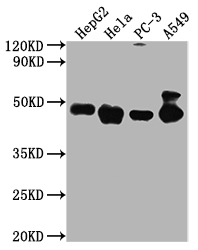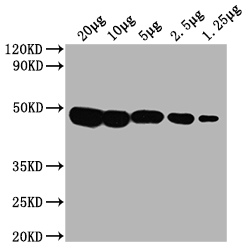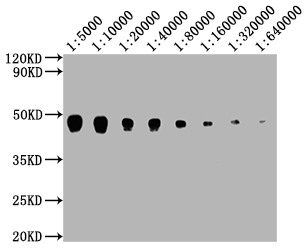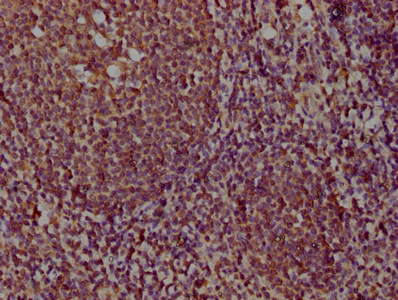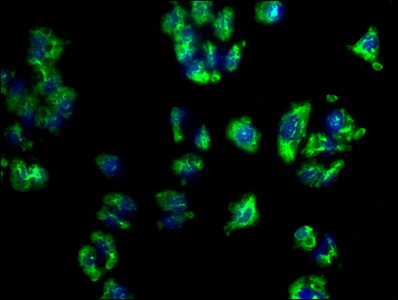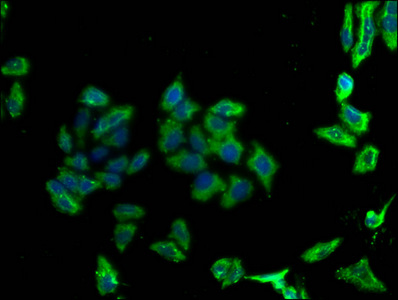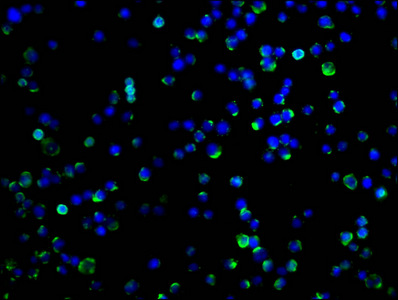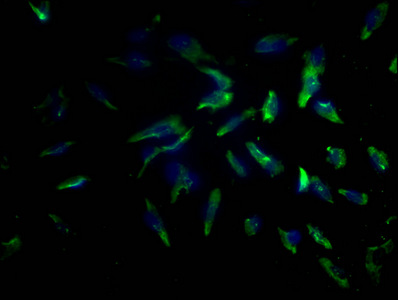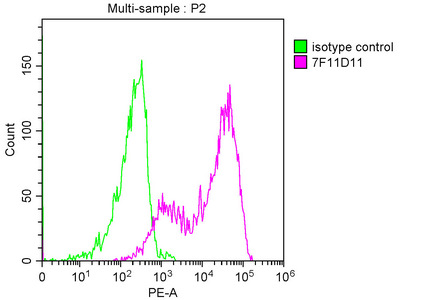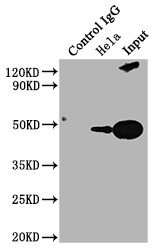| Image |
-
Western Blot
Positive WB detected in: HepG2 whole cell lysate, Hela whole cell lysate, PC-3 whole cell lysate, A549 whole cell lysate
All lanes PD-L2 antibody at 1:2000
Secondary
Goat polyclonal to mouse IgG at 1/50000 dilution
Predicted band size: 31,21 KDa
Observed band size: 45-50 KDa
Exposure time:5min
-
Western Blot
Positive WB detected in: Hela whole cell lysate at 20μg, 10μg, 5μg, 2.5μg, 1.25μg
All lanes: PD-L2 antibody at 1:2000
Secondary
Goat polyclonal to mouse IgG at 1/50000 dilution
Predicted band size: 31,21 KDa
Observed band size: 45-50 KDa
Exposure time:5min
-
Western Blot
Positive WB detected in: 15μg hela whole cell lysate PD-L2 antibody at 1:5000, 1:10000, 1:20000, 1:40000, 1:80000, 1:160000, 1:320000, 1:640000
Secondary
Goat polyclonal to mouse IgG at 1/50000 dilution
Predicted band size: 31,21 KDa
Observed band size: 45-50 KDa
Exposure time:5min
-
IHC image of CSB-MA017667A0m diluted at 1:100 and staining in paraffin-embedded human tonsil tissue performed on a Leica BondTM system. After dewaxing and hydration, antigen retrieval was mediated by high pressure in a citrate buffer (pH 6.0). Section was blocked with 10% normal goat serum 30min at RT. Then primary antibody (1% BSA) was incubated at 4°C overnight. The primary is detected by a biotinylated secondary antibody and visualized using an HRP conjugated SP system.
-
Immunofluorescence staining of HepG2 cells with CSB-MA017667A0m at 1:100, counter-stained with DAPI. The cells were incubated with the antibody overnight at 4°C. Nuclear DNA was labeled in blue with DAPI. The secondary antibody was FITC-conjugated AffiniPure Goat Anti-Mouse IgG (H+L).
-
Immunofluorescence staining of Hela cells with CSB-MA017667A0m at 1:100, counter-stained with DAPI. The cells were incubated with the antibody overnight at 4°C. Nuclear DNA was labeled in blue with DAPI. The secondary antibody was FITC-conjugated AffiniPure Goat Anti-Mouse IgG (H+L).
-
Immunofluorescence staining of Raji cells with CSB-MA017667A0m at 1:100, counter-stained with DAPI. The cells were incubated with the antibody overnight at 4°C. Nuclear DNA was labeled in blue with DAPI. The secondary antibody was FITC-conjugated AffiniPure Goat Anti-Mouse IgG (H+L).
-
Immunofluorescence staining of U251 cells with CSB-MA017667A0m at 1:100, counter-stained with DAPI. The cells were incubated with the antibody overnight at 4°C. Nuclear DNA was labeled in blue with DAPI. The secondary antibody was FITC-conjugated AffiniPure Goat Anti-Mouse IgG (H+L).
-
Overlay histogram showing 293 cells transfected with PD-L2 stained with CSB-MA017667A0m (red line). The cells were incubated in 10% normal goat serum to block non-specific protein-protein interactions followed by the antibody (2µg/1*106cells) for 1 h at 4°C. The secondary antibody used was R-PE-conjugated Goat Anti-Mouse IgG(H+L) at 1/100 dilution for 30min at 4°C. Isotype control antibody (green line) was mouse IgG2b (2µg/1*106cells) used under the same conditions. Acquisition of >10,000 events was performed.
-
Immunoprecipitating PD-L2 in Hela whole cell lysate
Lane 1: Mouse control IgG instead of CSB-MA017667A0m in Hela whole cell lysate
Lane 2: CSB-MA017667A0m (2µl) + Hela whole cell lysate (500µg)
Lane 3: Hela whole cell lysate (20µg)
For western blotting, the blot was detected with CSB-MA017667A0m at 1:2000, and a HRP-conjugated Protein G antibody was used as the secondary antibody at 1:2000
|

